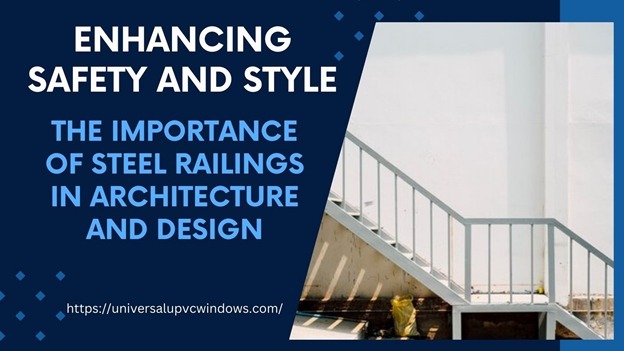Call Us
Email Us

Steel railing serves as a sophisticated and functional choice for both staircases and balconies, offering a touch of elegance and safety. The preferred option among many is stainless steel railing, renowned for its robustness, ability to withstand varying temperatures, corrosion resistance, and low maintenance requirements.
A railing is a barrier consisting of wooden or metal bars fastened to a wooden or metal post for stability. These are used to build terrace barriers, balcony barriers, stairwell railings, etc. The majority of architects favor steel for railing systems, while they can be built using a variety of materials. When it comes to value, appearance, and functionality, steel railing outperforms all other materials used for railings.
There are many different styles of steel railings; they might appear formal and classic or sleek and futuristic. Steel is strong, therefore with the correct care, a steel railing system may last for many years. For the owner, this means lower expenses and fewer replacement concerns.
Steel railings can be divided into two categories based on the kinds of steel that were used to make them:
Stainless steel railings are frequently used for covered or indoor railings. Rust and corrosion cannot harm these railings. Stainless steel contains 10.5% chromium as well as additional additions that strengthen and increase the material's resistance to higher temperatures.
Stainless steel handrails add a clean and contemporary appearance to both residential and commercial buildings. To create a contemporary design, these handrails can also be combined with railings composed of other materials, such as glass. To prolong its life, it may be simply washed with soap and water.
The cost of carbon steel railings is lower than that of stainless steel railings. Since they are robust and long-lasting, they work well for inside railings where there is less exposure to adverse weather. A carbon steel railing's lifespan may be extended by painting it occasionally.
Because carbon steel doesn't withstand corrosion well, a protective coating is required to extend its lifespan. This is a cheap alternative, but it needs to be painted frequently to stay durable.
The following are some uses for steel railings:
The benefits of using steel to construct railings are listed below:
Steel is among the greatest materials to utilize for handrails and railings because of its exceptional strength and durability. Because steel resists weather, steel railings can be utilized both indoors and outside.
To increase durability, powder coatings, liquid paints, and primers can be applied to steel railings. Railings made of galvanized and stainless steel require little upkeep and may be cleaned with a sponge and a light detergent.
If exposed to excessive heat, steel railing may buckle and weaken. The cost of steel handrails and railings may be higher than that of other materials. Steel is heavy, making installation challenging. To transform it into a railing, specific machinery must be used, which must then be moved and placed.
The section of a staircase that people grasp for support when going up and down is known as a handrail or banister. Along the steps, the handrail system offers stability and continual guiding.
Several materials can be used to make a handrail, such as carbon steel, wrought iron, stainless steel, wood, etc. It is attached to two large balusters at either end of the railing and is supported by balusters, or vertical posts, that are built on the open side of a staircase.
In contrast, a railing is a structure designed to prevent anyone from slipping from the edge of stairs. A railing is constructed from several balusters, each of which is fastened to a different stair. These balusters are connected to the large balusters at the extremities of the stairs by a lengthy handrail that is fastened atop each of them.
The most common type of railings for both residential and commercial use are made of stainless steel. It is not only visually pleasing, but it also takes little upkeep and is long-lasting. Stainless steel has a high chromium concentration, which makes it corrosion-resistant. Other elements can improve its physical characteristics. Long-term use makes stainless steel railings more cost-effective even though they are more expensive than steel railings.
At Universal UPVC Windows & Doors, we are fully committed to providing Pune with the highest caliber of SS railing services. We ensure the toughness, longevity, and eye-catching beauty of your SS railings by offering customized solutions, using high-quality materials, and carrying out quick and easy installation processes. We kindly ask that you get in contact with us as soon as possible so that we can have the chance to introduce you to our exceptional services and show you how our SS railings can easily improve the security and aesthetic appeal of your valuable property. For professional advice and flawless installation services, get in touch with us.